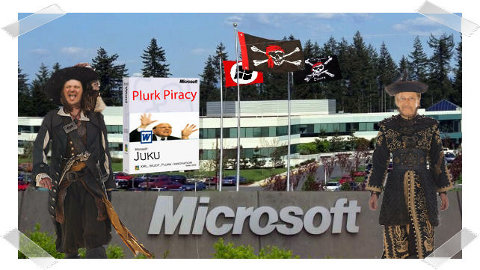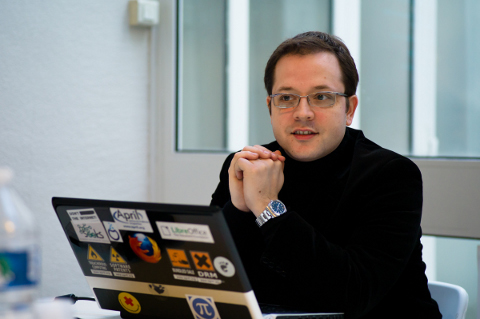03.07.14
Posted in Mandriva at 11:12 am by Dr. Roy Schestowitz
-
Today is a good day in many senses: winter ended and OpenMandriva Lx 2014 Alpha2 is here!
To keep up to high standards we decided to move Beta to RC1 date, and have Alpha2 today, to deliver you new fun according to the promise. This change does not affect the final release date.
-
Mageia has been one of my favorite projects and distributions since its inception, but Jesse Smith said today that the spell is broken for him. Smith had issues with his network connection upon first boot, but continued to have installation and updating of software issues. He complained of poor performance, missing packages, and a seriously annoying task switcher too. All in all, he wasn’t pleased. He concluded (in part)…
-
The PCLinuxOS Magazine staff is pleased to announce the release of the March 2014
issue. The PCLinuxOS Magazine is a product of the PCLinuxOS community, published
by volunteers from the community. The magazine is lead by Paul Arnote, Chief Editor,
and Assistant Editor Meemaw. The PCLinuxOS Magazine is released under the Creative
Commons Attribution-NonCommercial-Share-Alike 3.0 Unported license, and some
rights are reserved.
Permalink
 Send this to a friend
Send this to a friend
02.19.14
Posted in GNU/Linux, Mandriva at 8:36 am by Dr. Roy Schestowitz

Flags of the Baltic Sea countries
Summary: Russia continues to improve Mandriva, which used to be the most widely used GNU/Linux distribution for desktops (in the Mandrake days)
WITH Russia receiving Olympic limelight, it has become somewhat fashionable to publish Russophobic pieces in the Western media, focusing only on the negatives to distract from one's own shortcomings in the debt-saddled West (Russia has almost no debt and it has vast natural reserves). This is not a political post but an attempt to explain the state of Mandriva, which some years ago passed from French and Brazilian hands into Russian hands. Remember that Linux was created in Finland, a country highly influenced (and to some degree controlled) by the Russians — those whom Nils Torvalds worked with politically. Given what we now know about the NSA and GCHQ, it would only make sense for Russia to move to GNU/Linux everywhere as soon as possible. Given what Microsoft has done in Russia and has done with the NSA (espionage), only a “useful idiot” (to use Soviet terminology) would still put Windows on government or army computers in Russia.
Following the migration of Mandriva to Russia (finding financial asylum, so to speak) a new distribution called Rosa Linux came to us from Russia [1] with no language barriers, emerging out of nowhere and stealing some of the attention ALTLinux once enjoyed. There is a Russian (but English-speaking) blog that continues to cover Mandriva and its derivatives quite often (even days ago [2]) and Mandriva, which is now based and managed in Russia, makes new software releases [3]. A French derivative of Mandriva, called Mageia (employing several former Mandriva developers), is helping the good name of Mandriva (Mageia 4 was thoroughly reviewed some days ago [4]), not to mention the US semi-equivalent known as PCLinuxOS.
My experiences with Mandriva (main desktop operating system) have been mostly positive and it is important to assure the continued expansion of this GNU/Linux distribution, no matter who manages it. OpenMandriva gives it some independence from the Russia, and its community was led by a Frenchman until not too long ago. █
Related/contextual items from the news:
-
At the end of 90`s Mandrake Linux was the most popular distribution out there. Most thing that are today said about Ubuntu where first said about Mandrake. It was the number one distro from 1998 util 2004. User friendly, easy to use, easy to install, lot of preinstalled software, most popular by new users and Mandrake made at that point most users to change on Linux. All that is today said about Ubuntu. Yeah, Mandrake had also free shipping for DVDs back then. But soon the empire started to fall apart. In 2004 Mandrake had died. In 2005 Conectiva, the company who bought Mandrakesoft announced and released Mandriva and in 2006 they fired Gael Duval. Duval was the author of Mandrake. The new distribution, Mandriva, was nothing like good old Mandrake and it made lot of users to change their system. Fast forward to 2014 and let us have a look on the legacy of Mandrake Linux. Last stable release of Mandriva was in 2011 and it was not really stable. But in last 10 years Mandriva inspired many users and developers and new distributions popped out. One of them is Rosa Linux. Rosa Linux is a Russian Linux distribution.
-
-
The French GNU/Linux company Mandriva has released a new version of Pulse, its IT systems management software.
-
The project makes separate installation ISO images for the GNOME 3 and KDE desktop environments available for download. Support for other desktop environments – Cinnamon, Enlightenment (E17), LXDE, MATE, RazorQt and Xfce – are provided via the DVD installation and Network Install CD images
Permalink
 Send this to a friend
Send this to a friend
02.06.14
Posted in GNU/Linux, Mandriva at 6:50 am by Dr. Roy Schestowitz
Summary: Mageia 4 is out, PCLinuxOS is promoted at the expense of Ubuntu, and ROSA is being reviewed
As we had noted a week or so in advance, Mageia 4 was released in time for FOSDEM [1] and it received some press coverage [2]. There are galleries of screenshots online [3,4] and also some reviews [5,6]. These are generally very positive and they serve to show that the team did good work.
Other than that, PCLinuxOS received a recommendation [7]. It is said to be better for Windows XP users and judging by my father’s experience it is probably true. Windows XP users easily and quickly get accustomed to PCLinuxOS. The similarity in structure and appearance sure helps.
Speaking of another Mandriva derivative, ROSA is being reviewed again [8,9] and it’s looking good. Mandriva is now based in Russia and ROSA is a Russian distribution, whereas Mageia is mostly French and PCLinuxOS is developed in the US.
Don’t dismiss the Mandriva camp. It may not have a strong brand like Ubuntu’s or a development community as vast as Debian’s, but it sure is doing well. █
Related/contextual items from the news:
-
Right on time, and just in time for the first day of FOSDEM 2014, we have the great pleasure of announcing Mageia 4. We’re still having a grand time doing this together, and we hope you enjoy this release as much as we’ve enjoyed making it. And if you’re at FOSDEM, come and help us celebrate!
-
-
Default desktop of Mageia 4 GNOME has some flowery ornaments on the deep-blue background. As usual in GNOME, there is no dedicated menu, but there is an all-screen search tool. You may notice that there is no network indicator on the panel.
-
-
A few years ago (September 2010 to be exact), when things got really crazy with the Mandriva distribution, some of the core developers and users announced that they were establishing a fork to continue the development and distribution with the new name Mageia. That has proven to be a very good decision, because they have just made their fourth major release.
-
Aside from the KDE and GNOME 3 desktop environments, Mageia 4 also features support for Cinnamon and MATE. This article presents screen shots from test installations of the Cinnamon, GNOME 3 and KDE desktops.
-
This is not an attempt to disparage Ubuntu as it is a very good operating system and I would recommend it to most people. It is definitely a better step forward for Windows 7 users than Windows 8 would be.
-
ROSA Desktop is one of several distributions that are derived from Mandriva Linux. The others are Mageia and OpenMandriva. The latter has more in common with ROSA Desktop than Mageia does; many applications developed by ROSA labs are available in the OpenMandriva repositories, but not in the Mageia repositories.
-
However, in recent times the Russian company has introduced a new desktop lineup called ROSA “Fresh”. This desktop version is intended to be, as the name suggests, fresher in terms of software versions and therefore features etc whilst aiming to maintain stability and a good solid user experience and more than just KDE and Gnome versions have been made available.
Permalink
 Send this to a friend
Send this to a friend
01.26.14
Posted in GNU/Linux, Mandriva at 4:33 am by Dr. Roy Schestowitz
Long live RPM

Summary: Mandriva and its derivatives/relatives continue to produce good desktop distributions which are RPM-based
THE FAMILY of distributions derived from Mandrake (originally the ‘Red Hat camp’) are still contenders on the desktop, challenging the ‘Debian camp’ championed by Ubuntu and its derivatives (and other Debian derivatives like SteamOS). According to Mageia people who spoke to us last night, Mageia 4 is scheduled to be released in FOSDEM next week. There is already a release candidate [1,2] and a preview [3]. Mandriva, despite losing Charles-H. Schulz [4,5], is said to have just found an expansion route [6] and PCLinuxOS (a popular Mandriva/Mandrake derivative) is receiving good reviews [7] and releasing new magazines [8].
As we stated a few months ago, don’t discount the RPM/Red Hat camp just yet. It has plenty of potential and there are many eager, highly-motivated developers supporting it. █
Related/contextual items from the news:
-
The release candidate spin of the upcoming Mageia 4 Linux distribution from the Mandriva/Mandrake lineage is now available for testing.
-
Mageia, a GNU/Linux-based free operating system that started its life as a fork of Mandriva Linux and that is supported by a nonprofit organization of elected contributors, is now at version 4 RC.
-
Today’s stroll around the Linuxhood proved quite interesting as usual. First up are reviews of two distributions that get few reviews, so those are quite welcome. Debian developers get a free subscription to Steam if they want. And someone nicked Zoltan gives a nice overview of Mageia and its place in the Linux distro landscape. Today’s bonus is Matt Asay’s assertion that the Linux desktop doesn’t matter anymore.
-
Mandriva S.A. snagged the expertise of Charles-H. Schulz in May 2012 to help organize and basically sweep up after the restructuring of early 2012. Schulz, whose first job was with MandrakeSoft, left Mandriva S.A at the beginning of the year and wishes “success and good luck” to OpenMandriva.
-
The beginnings of the OpenMandriva project were rough. The very rationale for the existence of OpenMandriva were not overly clear to many people. After all, the Mageia project was already booming and the justification for such a project that was aiming at building upon the Mandriva Linux legacy was weak. On top of this, the team behind the project was small, and the mission was overwhelming: to continue, as a community, the development of the linux distribution formerly known as Mandriva Linux. I will not really go into details as to how the project evolved, but I am proud to have contributed in a significant way to build the home for this project, namely an independent French NGO (the OpenMandriva Association) and to have helped the community with establishing its governance and some of its sound principles and processes. But the question remains: why does the OpenMandriva Project matter? Why should we care?
-
Instead of being just a supplier of GNU/Linux, Mandriva has added plenty of software and services all its own aimed at businesses. They must even have salesmen… In their enthusiasm they wrote, “In 2006, hundred of millions of personal computers pre-installed with Linux were shipped, particularly to South America, East Europe, Russia, North Africa and India. Mandriva also participates in thematic projects with Intel, such as the Classmate PC.” With optimism/ambition like that they could go far. We await the next chapter…
-
This quarterly release from PCLinuxOS delivers the latest from KDE, LXDE, and MATE. Or you can try the famous PCLinuxOS Full Monty ISO which includes most/or all of the desktops listed above. I am slightly behind on my KDE updates so I will be reviewing PCLinuxOS 2013.12 KDE. For those that are wondering, this distribution is available in 32 or 64 bit architecture.
-
Download the PDF (10.7 MB) http://pclosmag.com/download.php?f=2014-01.pdf
Download the EPUB Version (9.7 MB) http://pclosmag.com/download.php?f=201401epub.epub
Download the MOBI Version (10.0 MB) http://pclosmag.com/download.php?f=201401mobi.mobi
Visit the HTML Version http://pclosmag.com/html/enter2014.html
Permalink
 Send this to a friend
Send this to a friend
12.24.13
Posted in GNU/Linux, Mandriva at 9:16 am by Dr. Roy Schestowitz
Summary: Derivatives of Mandriva are very much alive, with recent or upcoming releases
NOW, as in previous years, a new release of Mageia is imminent [1,2], promising to beat Mandriva to it [3] but not PCLinuxOS, which has just released its December edition (2013.12) [4]. Mandriva is now based in Russia and just like Red Hat (historically a relative of Mandriva) it might be benefiting from the NSA scandals. Well, governments cannot tolerate espionage and in Free/libre systems like Mandriva (with derivatives) not even KGB agents like Putin can successfully hide back doors.
For those who think that Mandrake/Mandriva are gone and are merely part of history it should be important to recognise forks and derivatives, including OpenMandriva. One day it might be a Mandriva derivative — not a RHEL or Debian derivative — that becomes the most widely used GNU/Linux distribution (or operating system). ChromeOS and SteamOS, for instance, are based on rather different systems of GNU/Linux. There’s no one-horse race. █
Related/contextual items from the news:
-
-
-
Nearly 18 months after the company was re-organised, Mandriva, the French GNU/Linux company is making progress towards a release, according to Charles-H. Schulz, its marketing and open source relations manager.
-
Permalink
 Send this to a friend
Send this to a friend
11.23.13
Posted in GNU/Linux, Mandriva at 5:43 pm by Dr. Roy Schestowitz

Summary: The “OpenMandriva” branch of Mandrake/Mandriva shows continuity in what used to be the leading GNU/Linux distribution for desktops/laptops
REMNANTS of Mandrake include PCLinuxOS, which is a wonderful distribution [1], but from Mandriva too comes a new release, known as OpenMandriva Lx 2013.0 [2,3]. The staff which left Mandriva is saying goodbye to Mageia 2 [4] and those who support Mandriva-based distros continue to shuffle [5], showing us that Mandriva is able to thrive in branches and forks. Having more choices is essential for a project’s survival and expansion. Mandrake/Mandriva was once the most widely used desktop distribution. It can still make a huge comeback. █
Related/contextual items from the news:
-
If you prefer the do-it-your way experience, opt for the KDE MiniMe version. You will get a basic KDE desktop to configure your way. This version is intended for advanced users who know how to fine-tune their system. It is a much smaller ISO file that lacks printer drivers. You add what drivers you need as well as whatever other elements you want beyond the bare-bones KDE installation. – See more at: http://www.linuxinsider.com/story/PCLinuxOS-Makes-Desktop-Linux-Look-Good-79418.html#sthash.VNYARlCM.dpuf
-
-
The OpenMandriva Lx teams are pleased to announce the availability of the 2013.0 final release!
-
-
2. PCLinuxOS has been updated and it now fixed the SCIM IME. That is simply great! PCLinuxOS 32 bits is my gaming OS as it gets to play my DESURA and STEAM games perfectly.
3. Mageia 3 remains the same with some updates. This is my academic distro and my family OS (it was user accounts for my family)
Permalink
 Send this to a friend
Send this to a friend
11.15.12
Posted in Mandriva, Microsoft, Vista 8, Windows at 2:19 pm by Dr. Roy Schestowitz
Summary: Vista 8 and bloat on Surface lead to lawsuits already; Microsoft too focused on disrupting the winner (Linux/Android) and not on fixing its own products
WINDOWS and Surface are two old brands (the latter is being reused), but they cannot on their own guarantee the survival of a monopoly. Vista 8 is missing the boat and the Windows franchise gradually dies. Microsoft is unable to become a hardware company and now come the lawsuits we expected, starting with Sokolowski:
Andrew Sokolowski, a lawyer in Los Angeles, claims that he bought a Surface with 32 gigabytes of storage last week. But he quickly ran out of space after loading it with music and Microsoft Word documents. He discovered that a significant portion of the 32 GB storage space was being used by the operating system and pre-installed apps such as Word and Excel. Only 16 GB was available for him to use.
Here is commentary from a pro-Linux site:
Microsoft’s Surface tablet allocates almost 50% of the storage for itself thus leaving a user with 16GB on a 32GB tablet. Microsoft said in a statement. “Customers understand the operating system and pre-installed applications reside on the device’s internal storage thereby reducing the total free space.”
That sounds like an extremely poor operating system which has such a huge overhead.
My 16GB Google Nexus 7 tablet offers me more than 13GB of storage allocating less than 2.8 GB for the system, same is the case with other Android devices. The way Microsoft’s mobile OS reserves lion’s share of storage to itself is outrageous and shows how inferior the OS is when compared with Android.
Android can be much smaller. The problem is, Microsoft tried shoehorning a desktop OS into a mobile device.
sinofsky is said to have been thrown out for this strategic blunder and Semiaccurate says that Microsoft has failed:
Microsoft is in deep trouble, their two main product lines are failing, and the blame game is intensifying. Steve Sinofsky gets the blame this time for the failure of Windows 8, but the real problem is the patterns that are so clearly illustrated by these actions.
Microsoft is largely irrelevant to computing of late, the only markets they still play in are evaporating with stunning rapidity. Their long history of circling the wagons tighter and tighter works decently as long as there is not a credible alternative, and that strategy has been the entirety of the Microsoft playbook for so long that there is nothing else now. It works, and as the walls grow higher, customer enmity builds while the value of an alternative grows. This cycle repeats as long as there is no alternative. If there is, everything unravels with frightening rapidity.
A company that plays this game for too long becomes set in their ways, and any chance of real change simply becomes impossible. Microsoft is there, and has been for a long long time. Their product lines have stagnated, creating customer lock in is prioritized over creating customer value, and the supply chain is controlled by an iron fisted monopoly. Any attempt at innovation with a Windows PC has been shut out for over a decade, woe betide anyone who tried to buck that trend. The history books are littered with the corpses of companies that tried to make change the ‘Windows experience’. Microsoft’s displeasure is swift and fatal to those that try. Or at least it was.
A former Microsoft employee tried telling Sinofsky that it is a lost cause:
Congratulations on leaving Microsoft. Unless you have bills to pay, you won’t regret it. I left at the end of 2004, and have since studied a vast and amazing — but still flawed – world of computing out there.
For example, I discovered that we should already have cars that (optionally) drive us around and computers that talk to us. Linux on the desktop is powerful and rich but failing because of several strategic mistakes. Google claims to be a friend of Linux and free software, but most of their interesting AI code is locked up. Programming should be a part of basic math literacy for every child. The biotechnology world is proprietary like Microsoft, which is stunting progress in new medicines.
When Microsoft turns to Linux it often ends up badly. Even Microsoft veterans are a problem, e.g. when they hijack VMware, only to end up as trolls with "big boobs" type of jokes:
Thanks, VMware. In Microsoft’s case it turned out that nothing was using that value and it could be replaced without breaking things.
That’s according to the UEFI guy, who helped legitimise a headache to Linux users. As we explained before, Microsoft is too focused making life miserable for Android distributors (with UEFI requirements and patent litigation), so it loses sight of its own products, Even when Vista 8 is given away cheaply or for free people now choose Linux/Android. What an interesting time it is to be a Linux/FOSS advocate! █
“It’s easier for our software to compete with Linux when there’s piracy than when there’s not.”
–Bill Gates

Picture sent by a reader
Permalink
 Send this to a friend
Send this to a friend
06.26.12
Posted in IBM, Mandriva, Office Suites, OpenDocument, OpenOffice at 10:17 am by Dr. Roy Schestowitz

Summary: An interview with the Open Source Relations Manager of Mandriva, one who is boasting a pivotal role in the free office suites space
MR. Charles-H. Schulz is prominent in the Free/open source world and he is no stranger to Techrights. 4 years ago we wrote about him in relation to ODF advocacy and a year later we interviewed him. Recently, Charles got an appointment at Mandriva and last week he also got married. We decided to catch up and learn more about Mandriva, Openoffice.org, and LibreOffice.
Techrights: Please explain to us your role in Mandriva.
Charles-H. Schulz: My official title is “Open Source Relations Manager”. My role is to help with the general open source strategy of Mandriva SA, and that implies several levels of involvement, either with the community or with the corporate level as well.
How does one go about transitioning from a corporate-centric model into a community-based one?
The answer is both simple and complex at the same time. Let’s define the terms here for the sake of clarity. A corporate centric model of open source governance, or better, a corporate centric model of FOSS project is a model where one corporation defines the project, is supposed to reap the benefits out of it, has a weak governance structure, and where most of the contributors are individuals who contribute to the project are individuals who are employed by the said corporation or by its affiliates.
“It’s a model that allows for a diversity of stakeholders to get involved at various levels of the project, from the contributor to the leadership.”A community-centric model is not a model where there are no corporations around. It’s a model that allows for a diversity of stakeholders to get involved at various levels of the project, from the contributor to the leadership. It is also a model where the governance structure tends to be more defined, because the project is actually much more independent and does not rest on one sponsor for most of its resources and contributors.
So how do we transition from the former to the latter is by assessing what the main sponsor can offer, and by setting up a governance structure that allows a diversity of contributors to get involved. The resources question here is crucial. What do we need? How many servers? What’s the migration process? And of course, what’s the governance, and how do we make the new project truly independent from the former sponsor (regardless of the friendly or unfriendly relationship with this sponsor)?
I think the keyword here is “contributor”. If you have enough contributors outside the main sponsor who are coming from diverse affiliations, then you have a sustainable project.
That’s the kind of questions we have been studying on the 19th of June in Paris together with the Mandriva Linux community representatives. I think the results are very encouraging, and that we manage to make sense of what we want to do, how we are going to do it and why we do it; now we are entering the actual phase of work, and we’ll try to keep this committee work effective while trying to involve the community at large on specific areas.
What office suite does Mandriva use by default and why?
Mandriva uses LibreOffice by default. And if you ask why, it’s simply because it’s the best free office suite ever.
You have had experience ushering a community from one project (OpenOffice.org) to another (LibreOffice) amid times of uncertainty and great risk. Are these are parallels to this case?
I think there are, although here we have the main sponsor, Mandriva SA, who is very open about the reasons why it can no longer sustain a Linux distribution project on its own, and therefore is working directly with the community to make an independent project emerge. That’s the main difference. There are parallels though that tend to be more subtle: What we’re trying to achieve, just like with the transition from Openoffice.org to LibreOffice, is a culture shift from “it will get done by someone else” to “we must do it”. In other words, there is the same demand and urge to set up a fully meritocratic system.
How is collaboration between OpenOffice.org and LibreOffice coming along?
You mean between Apache OpenOffice and LibreOffice? Because Openoffice.org is dead, and it had several children. The collaboration is limited on practical terms because of the licensing differences, but we are rebasing our code on the latest Apache OpenOffice in order to be able to have a cleaner licensed base. Right now, we must still deal with the LGPL v3, and while it’s a great licence it cannot change over time; so we have embarked in a relicensing effort towards MPL v2 and GPL v3+ and we are looking forward the interesting switch at Apache OpenOffice from the Openoffice.org codebase to the Symphony codebase; there will certainly be some code we might be able to reuse. Although, when you come to think of it, it’s funny to enter the Apache Incubation Process with one software you’re inheriting, and to use a different software you’ve also inherited just after the incubation process is completed 
Mandriva was once one of the most used (if not the most used) distributions of GNU/Linux. Where would you position the distribution on those terms in 2012?
“What we will end up seeing in 2012 and onwards, is a great community powered distribution that’s separate from the company itself; and the company offering a range of Linux-powered products and platforms for the enterprise and the education market.”Let’s face it, the Mandriva Linux distribution was for years the most widely used distribution around. It’s not the case anymore. Several changes happen in the GNU/Linux distribution market and Mandriva never really caught them. It’s not so much that the distribution became outdated: if anything, using Mandriva today, or its fork, Mageia, shows just as advanced, beautiful and user-friendly the distribution is. But the alignment between a sound corporate strategy and the community side of things was never really thought of until now. What we will end up seeing in 2012 and onwards, is a great community powered distribution that’s separate from the company itself; and the company offering a range of Linux-powered products and platforms for the enterprise and the education market. So if anything, you’ll see more of Mandriva as a corporate distribution, and more of the Mandriva Linux community as a community distribution; there is no fork here, but a friendly and productive relationship with no exclusive reliance on each other.
Congratulations on the wedding. Have you gotten the wife using GNU/Linux yet?
 Oh, when I met Melissa she was already using the Gimp on Windows. She’s a very creative individual, and a few months after the beginning of our relationship, her old laptop broke. I introduced her to GNU/Linux; she used various distributions: Ubuntu for a long time, but also Mandriva, and now she’s a very happy Fedora user. I should also add that she created all of our wedding decorations, from the menus to the walls,
Oh, when I met Melissa she was already using the Gimp on Windows. She’s a very creative individual, and a few months after the beginning of our relationship, her old laptop broke. I introduced her to GNU/Linux; she used various distributions: Ubuntu for a long time, but also Mandriva, and now she’s a very happy Fedora user. I should also add that she created all of our wedding decorations, from the menus to the walls,
with the Gimp; she’s a poweruser of the Gimp and there are several community members, including me, who approached her asking whether she’d be interested in providing video tutorials for the project. █
Permalink
 Send this to a friend
Send this to a friend
« Previous entries Next Page » Next Page »






 Oh, when I met Melissa she was already using the Gimp on Windows. She’s a very creative individual, and a few months after the beginning of our relationship, her old laptop broke. I introduced her to GNU/Linux; she used various distributions: Ubuntu for a long time, but also Mandriva, and now she’s a very happy Fedora user. I should also add that she created all of our wedding decorations, from the menus to the walls,
Oh, when I met Melissa she was already using the Gimp on Windows. She’s a very creative individual, and a few months after the beginning of our relationship, her old laptop broke. I introduced her to GNU/Linux; she used various distributions: Ubuntu for a long time, but also Mandriva, and now she’s a very happy Fedora user. I should also add that she created all of our wedding decorations, from the menus to the walls,















 Content is available under CC-BY-SA
Content is available under CC-BY-SA